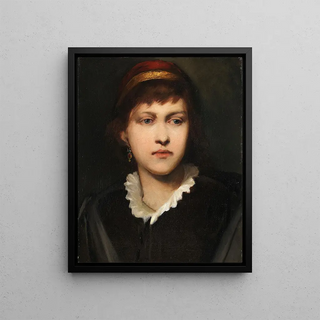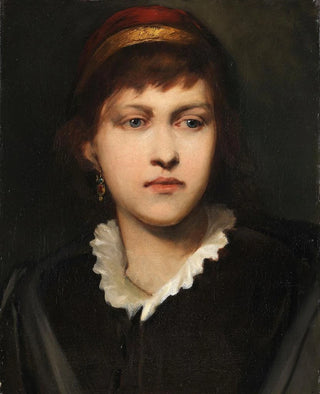Art print | Portrait of a girl with a bonnet and earrings - Gabriel von Max


View from behind

Frame (optional)
In the vast panorama of art, some works manage to capture the essence of an era and transport us to the heart of a palpable emotion. The "Portrait of a girl with a bonnet and earrings" by Gabriel von Max is one of those creations that fascinate with their delicacy and depth. This piece, imbued with an intimate atmosphere, reveals not only the technical virtuosity of the artist but also a subtle understanding of human psychology. Contemplating this portrait, the viewer is invited to question the identity and thoughts of the young girl, whose gaze seems to transcend time and space, establishing a direct connection with the observer.
Style and uniqueness of the work
Gabriel von Max's style is characterized by a unique approach that blends realism and symbolic elements. In this portrait, the depiction of the young girl is imbued with a softness and fluidity that make the work particularly endearing. The meticulous details, such as the sparkling earrings and the delicately draped bonnet, testify to a concern for detail that is the artist's signature. The chosen color palette, soft and harmonious, helps create an atmosphere of serenity. Light plays a crucial role, illuminating the young girl's face in a way that enhances her expressiveness. Thus, each element of the composition seems to dialogue with the others, forming a coherent whole that invites contemplation.
The artist and his influence
Gabriel von Max, an emblematic figure of the 19th century, is often recognized for his ability to fuse art and psychology. His training with renowned masters and his immersion in the artistic currents of his time allowed him to develop a style that is uniquely his own. Max was not just a portraitist but also a keen observer of the human condition. His interest in psychology is reflected in each of his portraits, where he manages to capture moments of pure emotion. The influence of his travels and his encounters with diverse cultures enriches his work, enabling him to incorporate narrative and symbolic elements that transcend simple representation.

Matte finish

View from behind

Frame (optional)
In the vast panorama of art, some works manage to capture the essence of an era and transport us to the heart of a palpable emotion. The "Portrait of a girl with a bonnet and earrings" by Gabriel von Max is one of those creations that fascinate with their delicacy and depth. This piece, imbued with an intimate atmosphere, reveals not only the technical virtuosity of the artist but also a subtle understanding of human psychology. Contemplating this portrait, the viewer is invited to question the identity and thoughts of the young girl, whose gaze seems to transcend time and space, establishing a direct connection with the observer.
Style and uniqueness of the work
Gabriel von Max's style is characterized by a unique approach that blends realism and symbolic elements. In this portrait, the depiction of the young girl is imbued with a softness and fluidity that make the work particularly endearing. The meticulous details, such as the sparkling earrings and the delicately draped bonnet, testify to a concern for detail that is the artist's signature. The chosen color palette, soft and harmonious, helps create an atmosphere of serenity. Light plays a crucial role, illuminating the young girl's face in a way that enhances her expressiveness. Thus, each element of the composition seems to dialogue with the others, forming a coherent whole that invites contemplation.
The artist and his influence
Gabriel von Max, an emblematic figure of the 19th century, is often recognized for his ability to fuse art and psychology. His training with renowned masters and his immersion in the artistic currents of his time allowed him to develop a style that is uniquely his own. Max was not just a portraitist but also a keen observer of the human condition. His interest in psychology is reflected in each of his portraits, where he manages to capture moments of pure emotion. The influence of his travels and his encounters with diverse cultures enriches his work, enabling him to incorporate narrative and symbolic elements that transcend simple representation.






